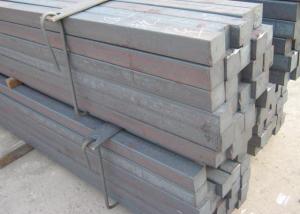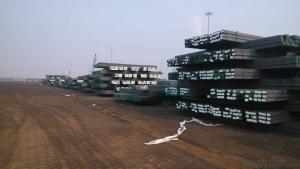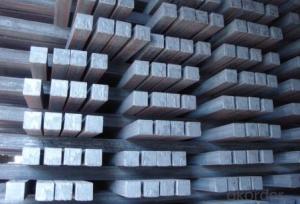Hot Rolled Square Steel Bars with Cromo to Make Parts of Structure
- Loading Port:
- Tianjin
- Payment Terms:
- TT or LC
- Min Order Qty:
- 25 m.t.
- Supply Capability:
- 200000 m.t./month
OKorder Service Pledge
OKorder Financial Service
You Might Also Like
Product Description:
OKorder is offering Hot Rolled Square Steel Bars with Cromo to Make Parts of Structure at great prices with worldwide shipping. Our supplier is a world-class manufacturer of steel, with our products utilized the world over. OKorder annually supplies products to European, North American and Asian markets. We provide quotations within 24 hours of receiving an inquiry and guarantee competitive prices.
Product Applications:
-The Hot Rolled Square Steel Bars with Cromo to Make Parts of Structure is normally used as structure steel.
-Row material for other structure steel like steel angles, channels, I-beams, H-beams, etc…
-Row material for steel pipes.
Product Advantages:
Hot Rolled Square Steel Bars with Cromo to Make Parts of Structure are durable, strong, and resists corrosion.
Main Product Features:
· Premium quality
· Prompt delivery & seaworthy packing (7-10 days after receiving deposit)
· Corrosion resistance
· Can be recycled and reused
· Mill test certification
· Professional Service
· Competitive pricing
Product Specifications:
-Standard: GB,
-Grade: Q235 or equivalent.
Chemical Composition:
Standard | Grade | Element (%) | ||||
GB | Q235B | C | Mn | S | P | Si |
0.12~0.20 | 0.30~0.70 | ≤0.045 | ≤0.045 | ≤0.30 | ||
Measures of Hot Rolled Square Bar:
-Length of a side and Theoretical weight of Square Bar.
Length of a side(mm) | Theoretical weight(kg/m) | Length of a side(mm) | Theoretical weight(kg/m) |
6 | 0.283 | 32 | 8.04 |
7 | 0.385 | *33 | 8.55 |
8 | 0.502 | 34 | 9.07 |
9 | 0.636 | *35 | 9.62 |
10 | 0.785 | 36 | 10.17 |
11 | 0.950 | 38 | 11.24 |
12 | 1.13 | 40 | 12.56 |
13 | 1.33 | 42 | 13.85 |
14 | 1.54 | 45 | 15.90 |
15 | 1.77 | 48 | 18.09 |
16 | 2.01 | 50 | 19.63 |
17 | 2.27 | 53 | 22.05 |
18 | 2.54 | *55 | 23.6 |
19 | 2.82 | 56 | 24.61 |
20 | 3.14 | *58 | 26.4 |
21 | 3.46 | 60 | 28.26 |
22 | 3.80 | 63 | 31.16 |
*23 | 4.15 | *65 | 33.17 |
24 | 4.52 | *68 | 36.3 |
25 | 4.91 | 79 | 38.49 |
26 | 5.30 | 75 | 44.16 |
*27 | 5.72 | 80 | 50.24 |
28 | 6.15 | 85 | 56.72 |
*29 | 6.60 | 90 | 63.59 |
30 | 7.06 | 95 | 70.85 |
*31 | 7.54 | 100 | 78.50 |
Notes:
1, The theoretical weights in the list, base on the density of 7.85 g/cm3.
2, Formula for theoretical weight of Square bar: a(length of a side) * a * 0.00785
3, The numbers with *mean that they are not regular or we don’t offer them.
-Regular length of Square Bar:
Steel | Length of a side (mm) | Length of steel (m) |
Normal steel | < 25 | 4~10 |
> 25 | 3~9 | |
Steel of high quality | All measure | 2~6 |
Tool steel >75 | 1~6 |
FAQ:
Q1: Why buy Materials & Equipment from OKorder.com?
A1: All products offered byOKorder.com are carefully selected from China's most reliable manufacturing enterprises. Through its ISO certifications, OKorder.com adheres to the highest standards and a commitment to supply chain safety and customer satisfaction.
Q2: How do we guarantee the quality of our products?
A2: We have established an advanced quality management system which conducts strict quality tests at every step, from raw materials to the final product. At the same time, we provide extensive follow-up service assurances as required.
Q3: How soon can we receive the product after purchase?
A3: Within three days of placing an order, we will begin production. The specific shipping date is dependent upon international and government factors, but is typically 7 to 10 workdays.


- Q: How do you use a steel square for creating accurate rabbet cuts?
- To use a steel square for creating accurate rabbet cuts, follow these steps: 1. Measure and mark the dimensions of your desired rabbet cut on the wood surface. This will include the width and depth of the rabbet. 2. Place the steel square on the edge of the wood, aligning one side of the square with the surface of the wood. 3. Hold the steel square firmly in place with one hand while using a pencil or marking knife to trace along the other side of the square. This will create a straight and accurate guideline for your rabbet cut. 4. Repeat this process on the adjacent side of the wood, using the same measurement and aligning the square with the previously marked line. This will ensure parallelism and accuracy in your rabbet cut. 5. Use a chisel, router, or table saw to remove the material within the marked lines, following the straight guideline created by the steel square. Take your time and make precise cuts to achieve a clean and accurate rabbet. 6. After completing the rabbet cut, use the steel square again to check for squareness and ensure that the corners of the rabbet are at perfect right angles. By using a steel square as a reference guide, you can maintain accuracy and precision in your rabbet cuts, resulting in clean and professional-looking woodworking projects.
- Q: How does a steel square assist in determining the correct angle for a beaded joint?
- A steel square is a versatile tool that can assist in determining the correct angle for a beaded joint in several ways. Firstly, a steel square has a 90-degree angle, which can be used as a reference to ensure that the beaded joint is perfectly perpendicular to the workpiece. By placing the square against the workpiece and aligning it with the joint, one can visually confirm if the joint is at a right angle or needs adjustment. Secondly, a steel square can be used to measure and transfer angles. The square typically has various degree markings along its edges, allowing for precise angle measurements. This is particularly useful when dealing with beaded joints that require specific angles, such as mitered corners or angled cuts. By using the square as a guide, one can accurately mark the desired angle on the workpiece and ensure a precise beaded joint. Additionally, the steel square can serve as a guide when cutting or shaping the materials for the joint. By aligning the square with the workpiece and marking the desired angle, one can use the square as a reference point while cutting or shaping the materials. This helps in achieving accurate and consistent angles across multiple pieces, resulting in a well-fitted and aesthetically pleasing beaded joint. In summary, a steel square assists in determining the correct angle for a beaded joint by providing a 90-degree reference, allowing for angle measurements and transfers, and serving as a guide during cutting and shaping processes. Its versatility and precision make it an essential tool for ensuring the accuracy and quality of beaded joints.
- Q: How do you use a steel square to lay out a hexagon?
- To use a steel square to lay out a hexagon, you would start by aligning the long edge of the square with the edge of your material. Then, using the 90-degree angle of the square, mark two points along the edge of the material. Next, rotate the square 60 degrees and mark two more points, making sure they align with the previous marks. Finally, rotate the square another 60 degrees and mark the remaining two points. Connect all the marked points, and you will have successfully laid out a hexagon using a steel square.
- Q: How do you use a steel square to determine the angle of a compound bevel cut?
- To use a steel square to determine the angle of a compound bevel cut, you would place the square against the material, ensuring that one edge is aligned with the surface to be cut. Then, you would adjust the square until the other edge is parallel to the desired bevel angle. By reading the angle measurement on the square, you can determine the angle needed for the compound bevel cut.
- Q: Can a steel square be used for checking the squareness of deck posts?
- Yes, a steel square can be used for checking the squareness of deck posts. A steel square, also known as a framing square or carpenter's square, is a versatile tool commonly used in carpentry and construction. It consists of a long arm and a shorter arm, forming a right angle. One of the primary purposes of a steel square is to ensure that corners and angles are perfectly square. To use a steel square for checking the squareness of deck posts, you can follow these steps: 1. Position the steel square against one side of the deck post, ensuring that the long arm rests against the post while the shorter arm extends vertically. 2. Observe the alignment of the shorter arm against the adjacent side of the deck post. If the post is perfectly square, the shorter arm of the steel square should be flush against the post without any gaps or overlaps. 3. Repeat this process on all four sides of the deck post to confirm its squareness. If the steel square consistently aligns flush with all sides, the post can be considered square. 4. In case the steel square does not align properly or there are gaps or overlaps, adjustments can be made to the post. This can involve repositioning or re-measuring the post, ensuring it is at right angles to the deck surface. It is important to note that while a steel square is an effective tool for checking the squareness of deck posts, it should be used in combination with other methods, such as measuring diagonals or using a level, to ensure accurate and precise results.
- Q: How do you use a steel square to determine the angle of a compound spindle sanding cut?
- To use a steel square to determine the angle of a compound spindle sanding cut, you will need to follow these steps: 1. Start by placing the steel square on a flat and level surface, such as a workbench or table. 2. Position the compound spindle sanding machine next to the steel square, ensuring that it is stable and securely held in place. 3. Adjust the angle of the compound spindle sanding machine to the desired angle for the cut. This can typically be done by loosening a locking mechanism or adjusting a knob on the machine. 4. Once the desired angle is set, hold the steel square against the sanding spindle or workpiece, ensuring that it is flush against both surfaces. 5. Look closely at the steel square and observe the angle formed between the square and the sanding spindle or workpiece. This angle represents the angle of the compound spindle sanding cut. 6. Take note of the angle measurement indicated by the steel square. Some steel squares may have angle markings or a protractor scale to assist with accurate measurements. 7. Use the determined angle measurement to guide your compound spindle sanding cut. You can adjust the angle of the machine or workpiece accordingly to achieve the desired result. Remember to always prioritize safety when working with power tools and machinery. Ensure that the compound spindle sanding machine is properly secured and that you are using appropriate safety equipment, such as goggles and gloves.
- Q: How do you use a steel square to measure the height of a cabinet?
- To use a steel square to measure the height of a cabinet, place the square vertically against the side of the cabinet, ensuring that it is flush with both the top and bottom edges. Then, read the measurement on the vertical side of the square where it aligns with the top of the cabinet. This will give you an accurate measurement of the cabinet's height.
- Q: How do you use a steel square to determine the angle of a coping cut?
- To use a steel square to determine the angle of a coping cut, you need to follow a few simple steps. First, ensure that the square is properly aligned and perpendicular to the material you are working with. This will help you obtain accurate measurements. Next, place the square against the edge of the material, making sure that one arm of the square is aligned with the surface of the material and the other arm is pointing towards the direction of the coping cut. Once the square is in position, observe the scale or measurement markings on the square. Most steel squares have a protractor or angle measuring scale etched on one of the arms. This scale will help you determine the angle of the coping cut. Now, look for the angle reading that aligns with the edge of the material. This will be the angle at which you need to make the coping cut. Make sure to double-check your measurements and ensure that the square is firmly in place before making any cuts. It is also recommended to use a pencil or a scribe to mark the angle on the material for accuracy. Remember that practice and experience will improve your ability to accurately determine the angle using a steel square.
- Q: Can a steel square be used for miter cuts?
- Certainly! A miter cut can indeed be accomplished with the aid of a steel square. This particular tool, which is alternatively referred to as a framing square or carpenter's square, possesses remarkable versatility in the realm of woodworking and carpentry. Within this field, it can be employed for a multitude of tasks, including the creation of precise miter cuts. The square exhibits a 90-degree angle as well as a 45-degree angle, both of which prove indispensable when endeavoring to produce meticulous miter joints. By aligning the square's edges with the material that is to be severed, it is feasible to employ it as a guide for marking and executing the desired angle. However, it is crucial to acknowledge that the utilization of a steel square for miter cuts necessitates scrupulousness and meticulous measurements to ensure utmost accuracy.
- Q: Can a steel square be used for checking the squareness of a foundation?
- Yes, a steel square can be used for checking the squareness of a foundation. A steel square is a versatile tool commonly used in carpentry and construction for checking and marking right angles. It consists of two arms, one of which is longer than the other, connected at a 90-degree angle. By placing the longer arm against a straight edge of the foundation and aligning the shorter arm with another edge, one can determine if the foundation is square or not. If the angles formed are 90 degrees, then the foundation is square. However, it is important to note that for larger foundations or when more accurate measurements are required, more precise tools like laser levels or transit levels may be used in conjunction with the steel square.
Send your message to us
Hot Rolled Square Steel Bars with Cromo to Make Parts of Structure
- Loading Port:
- Tianjin
- Payment Terms:
- TT or LC
- Min Order Qty:
- 25 m.t.
- Supply Capability:
- 200000 m.t./month
OKorder Service Pledge
OKorder Financial Service
Similar products
Hot products
Hot Searches
Related keywords



























